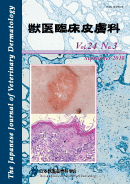
- Issue 4 Pages 207-
- Issue 3 Pages 141-
- Issue 2 Pages 73-
- Issue 1 Pages 3-
- |<
- <
- 1
- >
- >|
-
Shoko Momiyama, Yasushi Nunokawa, Nobuko Nunokawa, Ikeda Hirokazu, Ayu ...2018Volume 24Issue 3 Pages 141-145
Published: 2018
Released on J-STAGE: September 29, 2018
JOURNAL FREE ACCESSA 7-year-old castrated male Maltese was presented with multicentric erythema, erosion and crust on the face and footpads. A diagnosis of necrolytic migratory erythema (NME) due to hepatic cirrhosis was made following clinical and histopathological examinations. Cutaneous lesions and hypoalbuminemia improved after 32 days of combination treatment of liver support therapy, amino acid fluids, and intravenous adipose-derived stem cells (ADSCs) therapy. Skin lesions and hypoalbuminemia did not recur during 20 months of ADSCs therapy even after withdrawal of amino acid supplementation. These results suggest that ADSCs therapy could be an effective treatment option for canine NME.
View full abstractDownload PDF (2560K) -
Marie Hada, Kyouichi Tamura, Hiromitsu Orima, Takashi Komatsu, Takashi ...2018Volume 24Issue 3 Pages 147-152
Published: 2018
Released on J-STAGE: September 29, 2018
JOURNAL FREE ACCESSWe report two dogs with Zonisamide adverse drug reactions. Case 1, a 6-year-old, intact, female Maltese presented with erythroderma, and case 2, a 10-year-old, castrated, male miniature Pinscher showed erythema multiforme-toxic epidermolytic necrolysis. Both cases were suspected of having adverse drug reactions to Zonisamide based on their symptoms, blood test results and histopathologic findings. The eruptions completely disappeared with cessation of Zonisamide. A lymphocyte transformation test was carried out on both cases, but no positive reactions were seen. Further investigation of adverse reaction to Zonisamide, especially its incidence and pathogenesis, with more cases will be needed.
View full abstractDownload PDF (2558K)
-
Ryo Kono, Hirotaka Watanabe, Takafumi Osumi2018Volume 24Issue 3 Pages 153-155
Published: 2018
Released on J-STAGE: September 29, 2018
JOURNAL FREE ACCESSDownload PDF (1470K)
- |<
- <
- 1
- >
- >|